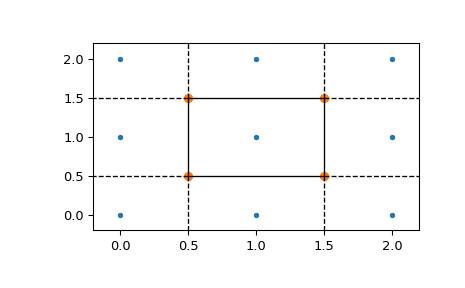scipy.spatial.Voronoi#
- class scipy.spatial.Voronoi(points, furthest_site=False, incremental=False, qhull_options=None)#
Voronoi diagrams in N dimensions.
New in version 0.12.0.
- Parameters:
- pointsndarray of floats, shape (npoints, ndim)
Coordinates of points to construct a Voronoi diagram from
- furthest_sitebool, optional
Whether to compute a furthest-site Voronoi diagram. Default: False
- incrementalbool, optional
Allow adding new points incrementally. This takes up some additional resources.
- qhull_optionsstr, optional
Additional options to pass to Qhull. See Qhull manual for details. (Default: “Qbb Qc Qz Qx” for ndim > 4 and “Qbb Qc Qz” otherwise. Incremental mode omits “Qz”.)
- Raises:
- QhullError
Raised when Qhull encounters an error condition, such as geometrical degeneracy when options to resolve are not enabled.
- ValueError
Raised if an incompatible array is given as input.
Notes
The Voronoi diagram is computed using the Qhull library.
Examples
Voronoi diagram for a set of point:
>>> import numpy as np >>> points = np.array([[0, 0], [0, 1], [0, 2], [1, 0], [1, 1], [1, 2], ... [2, 0], [2, 1], [2, 2]]) >>> from scipy.spatial import Voronoi, voronoi_plot_2d >>> vor = Voronoi(points)
Plot it:
>>> import matplotlib.pyplot as plt >>> fig = voronoi_plot_2d(vor) >>> plt.show()

The Voronoi vertices:
>>> vor.vertices array([[0.5, 0.5], [0.5, 1.5], [1.5, 0.5], [1.5, 1.5]])
There is a single finite Voronoi region, and four finite Voronoi ridges:
>>> vor.regions [[], [-1, 0], [-1, 1], [1, -1, 0], [3, -1, 2], [-1, 3], [-1, 2], [0, 1, 3, 2], [2, -1, 0], [3, -1, 1]] >>> vor.ridge_vertices [[-1, 0], [-1, 0], [-1, 1], [-1, 1], [0, 1], [-1, 3], [-1, 2], [2, 3], [-1, 3], [-1, 2], [1, 3], [0, 2]]
The ridges are perpendicular between lines drawn between the following input points:
>>> vor.ridge_points array([[0, 3], [0, 1], [2, 5], [2, 1], [1, 4], [7, 8], [7, 6], [7, 4], [8, 5], [6, 3], [4, 5], [4, 3]], dtype=int32)
- Attributes:
- pointsndarray of double, shape (npoints, ndim)
Coordinates of input points.
- verticesndarray of double, shape (nvertices, ndim)
Coordinates of the Voronoi vertices.
- ridge_pointsndarray of ints, shape
(nridges, 2) Indices of the points between which each Voronoi ridge lies.
- ridge_verticeslist of list of ints, shape
(nridges, *) Indices of the Voronoi vertices forming each Voronoi ridge.
- regionslist of list of ints, shape
(nregions, *) Indices of the Voronoi vertices forming each Voronoi region. -1 indicates vertex outside the Voronoi diagram. When qhull option “Qz” was specified, an empty sublist represents the Voronoi region for a point at infinity that was added internally.
- point_regionarray of ints, shape (npoints)
Index of the Voronoi region for each input point. If qhull option “Qc” was not specified, the list will contain -1 for points that are not associated with a Voronoi region. If qhull option “Qz” was specified, there will be one less element than the number of regions because an extra point at infinity is added internally to facilitate computation.
- furthest_site
True if this was a furthest site triangulation and False if not.
New in version 1.4.0.
Methods
add_points(points[, restart])Process a set of additional new points.
close()Finish incremental processing.